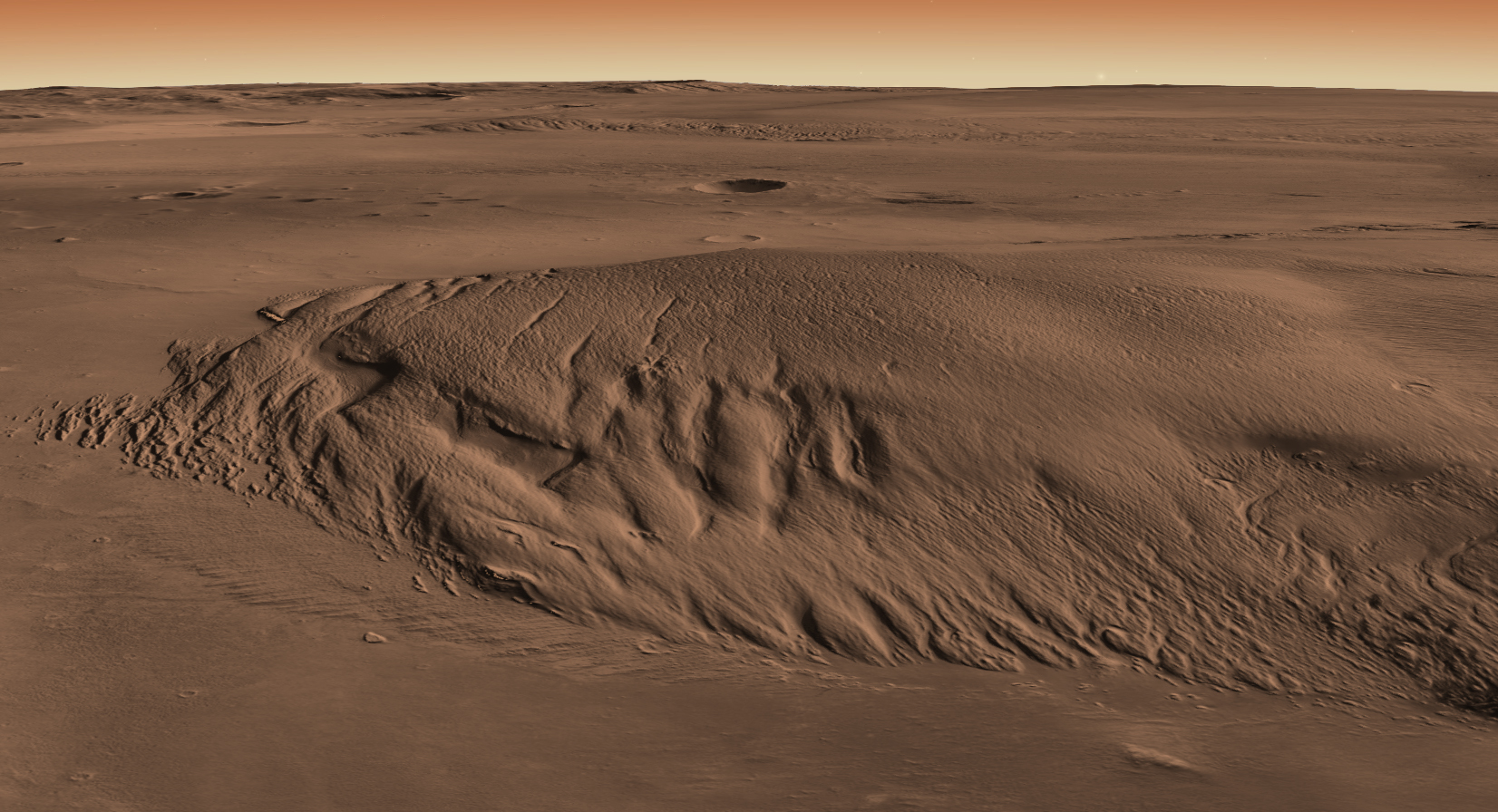New Study Reveals Evidence of an Ice-Rich Layered Deposit on Mars

Perspective view of Lucus Planum part of the Medusae Fossae Formation, a series of thick deposits found along the highland-lowland dichotomy boundary on Mars. The deposit shown here in this false color, Context Camera (CTX) mosaic, is several kilometers thick.
Credit: Caltech/JPL Global CTX Mosaic of Mars/Smithsonian Institution.
Findings from a recently published paper led by Smithsonian senior scientist emeritus Thomas R. Watters reveal evidence that the deposits of the vast Medusae Fossae Formation (MFF) may contain a significant volume of water ice. The paper, “Evidence of Ice-Rich Layered Deposits in the Medusae Fossae Formation of Mars,” published in the journal Geophysical Research Letters Jan. 18, presents new radar sounder data that show the similarity between the MFF deposits and the ice-rich polar layered deposits at the north and south poles of Mars. Modeling of the compaction behavior of proposed ice-free geologic materials shows that none of them can account for the inferred electrical properties of the MFF deposits without pore-filling ice.
“Finding evidence of layering in all the major units of the MFF makes a compelling case that the deposits are similar to the ice-rich polar layered deposits,” Watters said. “An ice-rich MFF deposit has important implications for the paleoclimate of Mars and could be potentially of great value to future human exploration of Mars. The MFF deposits are located at the Martian equator along the boundary between the northern lowlands and the heavily cratered highlands—an ideal landing spot for spacecraft as the lower elevation provides more atmosphere to slow a spacecraft’s decent.”
The MFF deposits remain one of the most enigmatic and least understood geologic units on Mars. Data from the Mars Advanced Radar for Subsurface and Ionospheric Sounding (MARSIS) instrument onboard European Space Agency’s Mars Express spacecraft initially revealed that the electrical properties of the MFF deposits were very similar to ice-rich polar layered deposits. New MARSIS data shows that similarities go beyond the electrical properties. Detection of interior subsurface reflectors indicate the presence of pervasive layering like that found in both the North Polar Layered Deposits (NPLD) and the South Polar Layered Deposits (SPLD) that are known to be ice-rich.
The new MARSIS data also shows the MFF deposits reach a maximum thickness of 3.7 kilometers (about 2 miles)—the maximum thickness of the SPLD. Compaction modeling of geologic materials proposed for the MFF deposits that include volcanic ash, windblown sediments and windblown rock dust shows that they cannot account for the inferred density and electrical properties of such a thick deposit.
Ice-rich MFF deposits, less a dry, insulating cover material possibly volcanic ash, represent a large reservoir of water in the equatorial zone of Mars. The estimated volume of water is up to 50% of that of the NPLD, much more than the total volume of water in the Great Lakes of North America. The volume of water is enough to cover the surface of Mars to a depth of about 1.5 to 3 meters (about 5 to 10 feet). The ice-rich MFF deposits were likely left at the Martian equator during periods of high obliquity when the present-day equator would have been much colder and the polar regions much warmer.
Watters is a senior scientist emeritus in the Center for Earth and Planetary Studies at the Smithsonian’s National Air and Space Museum and a member of the MARSIS science team.
The National Air and Space Museum’s Steven F. Udvar-Hazy Center is located in Chantilly, Virginia, near Washington Dulles International Airport, and is open daily from 10 a.m. to 5:30 p.m. Admission is free, but there is a $15 parking fee for vehicles entering before 4 p.m. at the Udvar-Hazy Center. The museum building on the National Mall in Washington, D.C., is located at Sixth Street and Independence Avenue S.W. and is open Thursday through Monday from 10 a.m. until 5:30 p.m. (closed Dec. 25). Admission is free, but timed-entry passes are required to visit the museum’s location in Washington.
# # #
SI-310-2023
